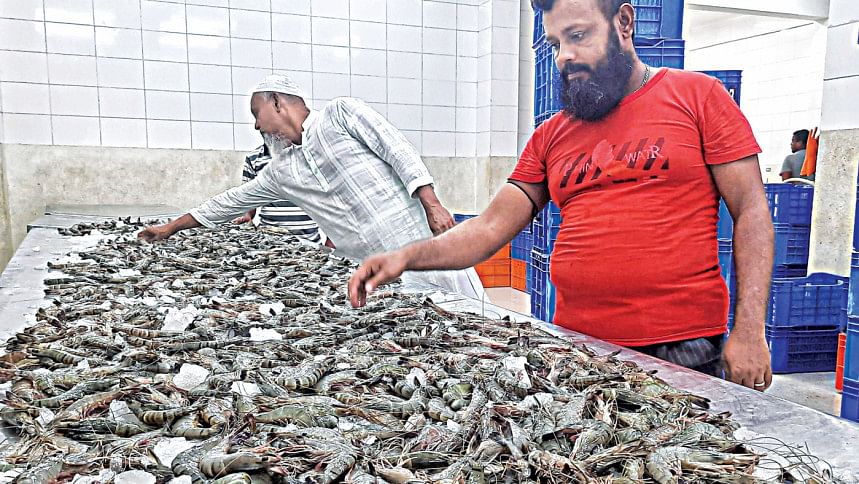Shrimp exports to face significant competition after LDC graduation

Shrimps, popularly referred to as "white gold" due to being one of Bangladesh's most valuable export items, may face significant pressure from competitor nations after the country graduates from Least Developed Country (LDC) status in 2026.
After graduating to a developing country, the nation will be required to remove subsidies on exports.
As a result, loss of tariff preferences and discontinuation of export subsidies could lead to significant pressure on Bangladeshi exporters of fish and fish products from competitors, according to a paper by Research and Policy Integration for Development (RAPID), which was presented at an event in Dhaka recently.
The Bangladesh Investment Development Authority, Fishery Products Business Promotion Council, and Bangladesh Frozen Foods Exporters Association jointly organised the event.
Bangladesh's exports of shrimp will face tariff increases of 0.52 percent and 0.46 percent to the European Union and United Kingdom markets respectively after graduation from LDC status, RAPID Executive Director M Abu Eusuf said in the paper.
As such, the country may lose around $9 million in earnings from fish exports as the benefits offered by the EU under its Generalized System of Preferences Plus scheme will be removed.
Bangladesh also stands to lose $1.6 million in duty benefits offered by the UK through its Enhanced Preference scheme, and $2.4 million in duty benefits from exports to India, according to the paper.
Eusuf reminded that Bangladesh would keep enjoying the existing duty-free access to the EU and UK for three more years after its graduation to a developing nation as the extension was endorsed by 166 members of the World Trade Organisation.
But changes in all other markets will start from November 2026.
The concerns were shared as Bangladesh's frozen and live fish exports are falling for a second consecutive year.
In the July-February period of FY2023-24, Bangladesh exported frozen and live fish worth US$274 million, down 12 percent year-on-year, according to Export Promotion Bureau data.
Meanwhile, Bangladesh's earnings from frozen fish exports stood at $382.3 million in FY2022-23, down 37 percent compared to nine years ago due to a lack of investment on technology and infrastructure.
This is leading to the loss of export markets in the EU and US, states the report.
Compared to FY2014-15, export earnings from the EU and US have fallen by 42 percent and 29 percent respectively in FY2022-23, it said.
Global shrimp sales amounted to $32 billion last year with the vannamei or whiteleg variety being the most sought-after, accounting for 83 percent of the total market, followed by black tiger shrimp at 8 percent, said the report.
Commercial farming of vannamei shrimp, which revolutionised the shrimp industry and is dominating the global market, was not implemented in a timely manner in Bangladesh, which is another reason for the fall in exports, it said.
In 2019, India, which largely produces vannamei shrimp, earned $4.7 billion from shrimp exports, which accounts for 24 percent of the total global revenue.
India achieved this using shrimp farms spread across only 160,000 hectares of land.
In contrast, Bangladesh earned only $330 million despite utilising 250,000 hectares of land for shrimp cultivation in FY2019-20.
Apart from the fall in export earnings, farming of fish, mainly shrimp, has also decreased over the years.
In 2012, 2.79 lakh hectares of land were utilised for shrimp farming. That number fell to 2.50 lakh hectares in 2022, which led to production decreasing by 35 percent.
"In spite of declining export performance, fish still holds the largest share of exported agricultural goods," said the report.
"In fact, this sector can serve as a potential avenue for export diversification and help Bangladesh move away from our heavy reliance on the apparel sector," it added.
In 2018, a decision to undertake pilot projects to cultivate vannamei shrimp was initiated.
Three pilot projects were successfully run, producing 8,000 to 10,000 kilogrammes (kgs) of vannamei per hectare. In contrast, the output for bagda shrimp was only 500 to 1,000 kg per hectare.
However, it will take another two to three years to reap the full benefits.
The study said a lack of quality and compliance with international standards were some of the major challenges barring the growth of the shrimp farming industry. It also stressed the need for the continuation of government support, development of a proper supply chain, and quality control measures.
The study also recommended the withdrawal of a 10 percent advance tax on cash assistance and ensuring loans to encourage scientific methods of cultivation and the establishment of shrimp-based economic zones.

 For all latest news, follow The Daily Star's Google News channel.
For all latest news, follow The Daily Star's Google News channel. 




Comments